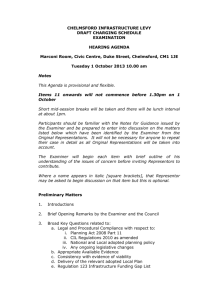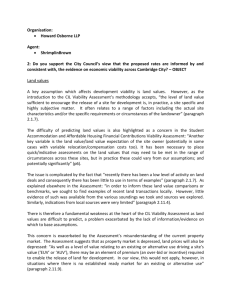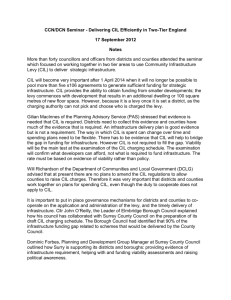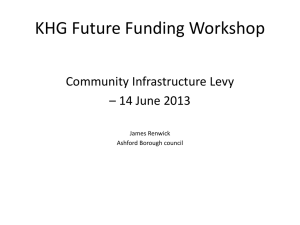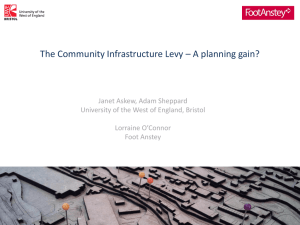report on the Conference - Royal Town Planning Institute
advertisement
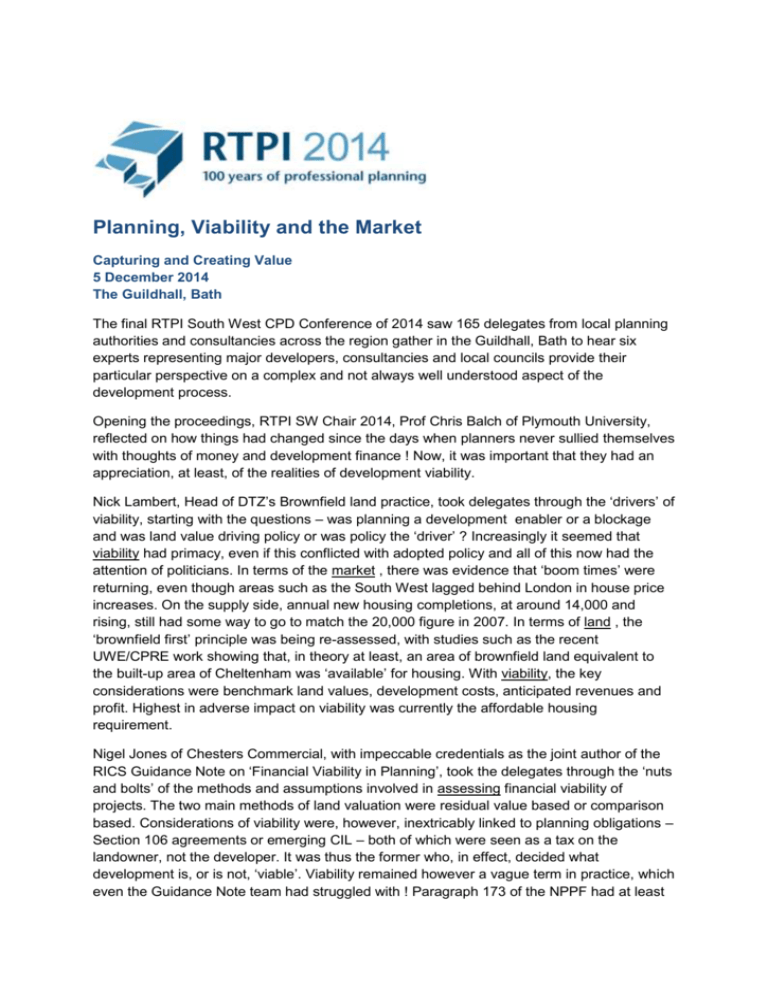
Planning, Viability and the Market Capturing and Creating Value 5 December 2014 The Guildhall, Bath The final RTPI South West CPD Conference of 2014 saw 165 delegates from local planning authorities and consultancies across the region gather in the Guildhall, Bath to hear six experts representing major developers, consultancies and local councils provide their particular perspective on a complex and not always well understood aspect of the development process. Opening the proceedings, RTPI SW Chair 2014, Prof Chris Balch of Plymouth University, reflected on how things had changed since the days when planners never sullied themselves with thoughts of money and development finance ! Now, it was important that they had an appreciation, at least, of the realities of development viability. Nick Lambert, Head of DTZ’s Brownfield land practice, took delegates through the ‘drivers’ of viability, starting with the questions – was planning a development enabler or a blockage and was land value driving policy or was policy the ‘driver’ ? Increasingly it seemed that viability had primacy, even if this conflicted with adopted policy and all of this now had the attention of politicians. In terms of the market , there was evidence that ‘boom times’ were returning, even though areas such as the South West lagged behind London in house price increases. On the supply side, annual new housing completions, at around 14,000 and rising, still had some way to go to match the 20,000 figure in 2007. In terms of land , the ‘brownfield first’ principle was being re-assessed, with studies such as the recent UWE/CPRE work showing that, in theory at least, an area of brownfield land equivalent to the built-up area of Cheltenham was ‘available’ for housing. With viability, the key considerations were benchmark land values, development costs, anticipated revenues and profit. Highest in adverse impact on viability was currently the affordable housing requirement. Nigel Jones of Chesters Commercial, with impeccable credentials as the joint author of the RICS Guidance Note on ‘Financial Viability in Planning’, took the delegates through the ‘nuts and bolts’ of the methods and assumptions involved in assessing financial viability of projects. The two main methods of land valuation were residual value based or comparison based. Considerations of viability were, however, inextricably linked to planning obligations – Section 106 agreements or emerging CIL – both of which were seen as a tax on the landowner, not the developer. It was thus the former who, in effect, decided what development is, or is not, ‘viable’. Viability remained however a vague term in practice, which even the Guidance Note team had struggled with ! Paragraph 173 of the NPPF had at least made the landowner/developer relationship clearer, but efforts to tax landowners’ financial gains from development had a long history : going back to the late 1940’s and the introduction of the modern planning system and more recently, in the Development Land Tax / Community Land Act initiatives in the 1970’s. More recently still, the Barker Report on housing supply had warned that over-taxation of landowners would lead to the supply of housing land drying up, whilst the Lyons Housing Review ( 2014) had suggested compulsory land acquisition in order to address the problem. On the matter of assessing market value of land, many of the traditional approaches had been rejected by the RICS team, which preferred to see market value as a ‘share in uplift’ in value created by a planning permission. Lionel Shelly, Development Viability Officer, Plymouth City Council, introduced himself as ‘ a development surveyor who had changed sides’. Using examples in Plymouth – a city to which he had returned after working in London and Europe – he spoke about the ‘dark art of negotiation’. Based on his experience, he advised all local planning authorities to challenge developer viability claims, which often came with baffling terminology ! Breaking down the arguments presented into their individual elements could aid understanding, as part of a negotiation process over which it was always worth taking time. The post-lunch session began by looking at the relationship between the emerging CIL process, viability and plan making. Lin Cousins of Three Dragons, explained the concept of ‘whole plan viability’ in which assessment was based on looking at all elements of a development plan, including policies on affordable housing, CIL, and housing design/quality, as well as plan’s policies overall. She noted that there was now plenty of central government guidance and regulation on CIL and referred to a study, by Three Dragons for DCLG, which had looked at the period 2011-2012.This showed that whilst most local planning authorities in England were planning to introduce the levy, the relationship between this and the well established Section 106 system had yet to be clarified and issues remained about how to set and collect the levy and about how to spend it. There were huge variations both between and within the regions on planned CIL take-up and average rates [ in £’s per square metre of development ] to be set. In the South West, about 70% of councils panned to use CIL, compared, for example, to only 20% in the North East and North West and the rates to be set in our region ranged between £20 and £120 ( a regional average of £75, compared to £125 in the South East and £140 plus the Mayoral CIL, in London. There had been little or no guidance so far on the process for allocating funds from the levies collected. In so allocating, councils were going to have to grapple with often conflicting priorities in making their decisions : all made extra complicated in 2 tier local government areas – as in much of the South West ! On large ‘strategic’ housing sites planning authorities were, in many cases, favouring the Section 106 approach rather than the application of CIL, because overall, developers would have to pay more that way. Developers would probably prefer this as well because with CIL they handed over complete control of spending on infrastructure etc to councils. Mary Elkington of Figura Planning, drew on her recent experience of putting CIL in place as a planning officer in Teignbridge, to reflect on the examination process of proposed schedules and upon future prospects for the system. Examinations of CIL proposals were taking place at the end of the year in several South West authorities – South Gloucestershire, West Dorset, Weymouth & Portland and BANES, all for example with hearings in December 2014. [ On 30 January 2015, the Examiner declared the BANES proposal, involving £50 per square metre on strategic sites, to be ‘reasonable, robust, proportional, and appropriate’ subject to just three modifications ] In Teignbridge, although the process of setting up the CIL had been run alongside that of preparing the Local Plan, they had not been examined together as the Inspector had wanted to get the policies in the latter clarified first. The Local Plan was adopted in May and the CIL in July 2014. Overall, there was evidence that the CIL process was becoming more routine and that the majority feeling was that this new regime was a good thing and would be in place for some time to come. The final speaker, Bath based developer Trevor Osborne, of the Trevor Osborne Property Group, brought all of his 50 plus years of experience in the business to bear in his reflections on the role of planning in helping or hindering successful development delivery. At a time when there was no planning system at all, he reminded delegates that it was pure market forces that drove John Wood to build the Royal Crescent ‘above the hamlet of Bath’ as part of a Georgian city which has now become a World Heritage Site! Nowadays, planners’ responsibilities to the community as a whole sat uneasily alongside the motives of developers, including profit/return on investment, return on capital employed, risk control. He added however, that making a worthwhile contribution to society was a genuine motive of many developers ! Market situations, he noted, were liable to change in unexpected ways, citing as an example, the fact that currently in Bath, land was more valuable as new student accommodation than it was for anything else other than retail use. Picking up on the issue of affordable housing referred to by previous speakers, he asked whether it really was the job of the development industry to build such dwellings ? Reflecting on the current severe housing shortage and the seeming lack of ‘acceptable’ solutions, he commended the Wolfson Prize completion initiative. Speaking as Chair of the judging panel, he enthused about the scale of the response - 274 entries- and believed that each of the five shortlisted ones was well worth reading for the quality of the intellectual thinking displayed. Whatever ‘solution’ to the housing crisis finally emerged, it was clear that many people were unhappy with the ‘standard dismal professional response’ of yet more town extensions ! It was also clear that new ‘garden cities’ would have to play a significant part. He was not at all sure that the current panning system could deliver a solution and even wondered whether there was even a need anymore for a local authority linked planning system ? Still, despite all this, his final message was to urge planning professionals to be positive and not to accept the popular public perception that they were a hindrance !! Geoff Walker RTPI SW Policy Project Officer February 2015
